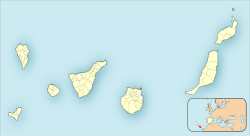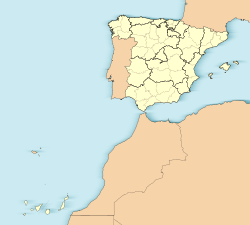Santa Cruz de Tenerife | |
|---|---|
| Nickname(s): "La Capital Chicharrera", "La Capital Tinerfeña", "La Capital Santacrucera", "The Sydney of the Atlantic".[1] | |
 Location of Santa Cruz de Tenerife | |
| Coordinates: 28°28′N 16°15′W / 28.467°N 16.250°W | |
| Country | Spain |
| Autonomous community | Canary Islands |
| Province | Santa Cruz de Tenerife |
| Island | Tenerife |
| Founded | 3 May 1494, founded as "Real de la Santa Cruz" |
| Government | |
| • Alcalde | José Manuel Bermúdez Esparza (CC) |
| Area | |
| • Municipality | 150.56 km2 (58.13 sq mi) |
| Elevation | 4 m (13 ft) |
| Population (2018)[4] | |
| • Municipality | 204,856 |
| • Density | 1,400/km2 (3,500/sq mi) |
| • Urban | 538,000[3] |
| Demonym(s) | Santacrucero, ra Chicharrero, ra |
| GDP | |
| • Metro | €17.138 billion (2020) |
| Time zone | WET |
| • Summer (DST) | WEST |
| Postal code | 38001-38010, 38107, 38108, 38110, 38160, 38320 |
| Dialing code | +34 922, +34 822 |
| Language | Spanish |
| Website | www |
Santa Cruz de Tenerife (Spanish: [ˈsanta ˈkɾuθ ðe teneˈɾife] ; locally [ˈsanta ˈkɾus ðe teneˈɾife]), commonly abbreviated as Santa Cruz, is a city, the capital of the island of Tenerife, Province of Santa Cruz de Tenerife, and one of the capitals of the Canary Islands, along with Las Palmas. Santa Cruz has a population of 206,593 (2013) within its administrative limits.[6] The urban zone of Santa Cruz extends beyond the city limits with a population of 507,306[7] and 538,000[3] within urban area. It is the second largest city in the Canary Islands and the main city on the island of Tenerife, with nearly half of the island's population living in or around it.
Santa Cruz is located in the northeast quadrant of Tenerife, 210 kilometres (130 mi) off the north-western coast of Africa within the Atlantic Ocean. The distance to the nearest point of mainland Spain is 1,300 kilometres (810 mi). Between the 1833 territorial division of Spain and 1927, Santa Cruz de Tenerife was the sole capital of the Canary Islands, until 1927 when the archipelago was split into the current two provinces.[8][9] The port is of great importance and is the communications hub between Europe, Africa and Americas, with cruise ships arriving from many nations. The city is the focus for domestic and inter-island communications in the Canary Islands.[10]
The city is home to the Parliament of the Canary Islands, the Audience of Accounts of the Canary Islands, the Captaincy General of the Canary Islands,[11] the Canarias Ministry of the Presidency (shared on a four-year cycle with Las Palmas), one half of the Ministries and Boards of the Canarias Government, (the other half being located in Gran Canaria), the Tenerife Provincial Courts and two courts of the Superior Court of Justice of the Canary Islands. There are several faculties of the La Laguna University in Santa Cruz, including the Fine Arts School and the Naval Sciences Faculty. Its harbour is one of Spain's busiest. It is important for commercial and passenger traffic as well as for being a major stopover for cruisers en route from Europe to the Caribbean. The city also has one of the world's largest carnivals. The Carnival of Santa Cruz de Tenerife now aspires to become a World Heritage Site, and is the second largest in the world.[12]
The varied architecture of the city stands out, highlighting the Auditorio de Tenerife (Auditorium of Tenerife), which is considered one of the greatest exponents of contemporary architecture. In the panoramic view of the city, the Torres de Santa Cruz (Santa Cruz Towers) also stand out, with the tallest twin towers in Spain at 120 meters (390 ft) high. Other outstanding places are the Plaza de España (Spain Square), which is the nerve center of the city, and the Parque García Sanabria (García Sanabria Park), a large urban park located in the center of the city. Outside the city but in its municipal district, Playa de Las Teresitas (Las Teresitas) and a large part of the Macizo de Anaga (Anaga Massif) stand out, declared a Biosphere Reserve by UNESCO in 2015. Santa Cruz de Tenerife hosts the first headquarters of the Center UNESCO in the Canary Islands. In recent years the city of Santa Cruz de Tenerife has seen the construction of a significant number of modern structures and the city's skyline is the sixth in height across the country, behind Madrid, Benidorm, Barcelona, Valencia and Bilbao.[13]
In 2012, the British newspaper The Guardian included Santa Cruz de Tenerife in the list of the five best places in the world to live, next to the Cihangir district, in Istanbul; the district of Sankt Pauli, in Hamburg, the north coast of Maui, in Hawaii and Portland, in Oregon.[14] The 82% of the municipal territory of Santa Cruz de Tenerife is considered a natural area, this is due in large part to the presence of the Anaga Rural Park. This fact makes Santa Cruz the third largest municipality in Spain with the highest percentage of natural territory, after Cuenca (87%) and Cáceres (83%).[15]
- ^ El nuevo perfil de Santa Cruz de Tenerife con el Auditorio Archived 24 June 2013 at archive.today
- ^ Instituto Canario de Estadística, area
- ^ a b Demographia: World Urban Areas – Demographia, 2015
- ^ Municipal Register of Spain 2018. National Statistics Institute.
- ^ "Gross domestic product (GDP) at current market prices by metropolitan regions". ec.europa.eu.
- ^ Instituto Canario de Estadística Archived 19 April 2014 at the Wayback Machine, population
- ^ Eurostat. "Population and living conditions in Urban Audit cities, larger urban zone (LUZ)".
- ^ Real Decreto de 30 de noviembre de 1833 on wikisource
- ^ Real Decreto de 30 de noviembre de 1833 Archived 22 July 2012 at the Wayback Machine at the official website of the Canary Islands Government
- ^ "Turismo Tenerife: Alojamiento, Carnaval, Actividades... – Tenerife". Archived from the original on 4 February 2010. Retrieved 25 May 2015.
- ^ Historial de la Capitanía General de Canarias Fuente: Ministerio de Defensa, Gobierno de España.
- ^ [1][dead link]
- ^ "Spain Skyscraper Diagram". Skyscraperpage.com. Retrieved 13 April 2011.
- ^ "Santa Cruz de Tenerife, uno de los cinco mejores sitios del mundo para vivir, según "The Guardian"". ABC. Madrid. 27 January 2012. Retrieved 25 May 2015.
- ^ Anaga convierte a Santa Cruz en la tercera gran ciudad de España con más suelo natural








